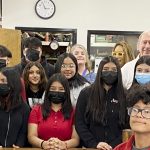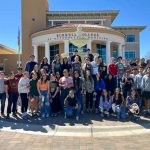From Fast Fashion to Lasting Change
In Elii Chapman’s 4th and 5th-grade art class, waste produced by the “fast fashion” industry sparked a powerful, interdisciplinary learning experience—one that connected global environmental issues, local community needs, and meaningful partnerships with higher education and community organizations.
Students at Thomas Elementary in Flagstaff, Arizona grappled with complex questions: How is our clothing made? Where does it go when we throw it away and what impact does that have on the environment? And, importantly, how can we make a difference?
Chapman’s students explored the history and human use of textiles—from ancient weaving to today’s global fast fashion industry. They learned about synthetic versus natural materials, global labor practices, and the environmental toll of mass-produced clothing. Using unsold garments donated by local businesses, they learned to sew, studied fiber labels, and considered how their textile-based art creations could benefit their community.
To deepen learning and bring real-world relevance, Elii partnered with Northern Arizona University’s Sociology Department through CommunityShare. Graduate students in a Participatory Research class regularly visited the classroom, engaging with students, documenting their process, and asking reflective questions about their art. The conversations were revealing.
“The grad students noticed many kids created animals and could clearly explain that they chose them because their habitats are being damaged by textile waste,” Elii said. “That insight—linking environment, art, and action—came straight from the students.”
These university-school partnerships went beyond observation. NAU students wrote a research paper based on the project and dialogue with students. The collaboration also modeled how local higher education can meaningfully connect with K–12 education to support student learning and raise awareness about their work.
The project began with awareness and led to action. Elii guided students to take their skills further—considering how their artwork can meet real needs in their community. They created ceramic dog bowls, baby blankets, pillows for unhoused individuals, and tic-tac-toe games for hospitalized children. They are beginning to organize donations of toothbrushes and nutrition bars for foster youth.
Chapman shared how the project has sparked agency and civic engagement among students: “Students are realizing ‘When I see a need, I can fill a need in a way that I can use my skills.’”
Through CommunityShare, Elii also connected with local businesses, Goodwill’s textile recycling program, and textile artists from out of state. “CommunityShare helps bring your ideas into conversation with real people… there’s a good chance that something is going to click and it’s going to make your project that much deeper.”
The project’s impact reached beyond the classroom—it was featured in the Arizona Daily Sun and stands as a vivid example of the real power of community-engaged learning. Learn more about the project in these features from Flagstaff Unified School District and the AZ Daily Sun.
Impact Spotlight
110 Students Impacted
Length of Project
6 months
Skill Building:
- Content Areas: Business, Science, Social Studies/History, Visual Arts





